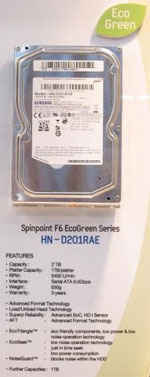New Samsung hard drives hit one terabyte areal density
By
David Murphy |
Updated on 08-Mar-2011


Heise Online is reporting that Samsung has broken the barrier on storage capacity for hard drives, pushing up to a one-terabyte-per-platter areal density in a new line of drives being shown off at this year’s CeBIT convention in Hanover, Germany.
The company plans to use this technology to create two-terabyte hard drives that use just two platters, which the company was demonstrating at the convention. Future releases also include three- and four-terabyte hard drives, or nearly double the two-terabyte limit of consumer hard drives in the present-day.
Samsung’s two-terabyte, two-platter disc—otherwise known by its model name, HN-D201RAE—will launch as part of the company’s Spinpoint EcoGreen series of drives. These 5,400-RPM hard disks use slower rotational speeds to achieve greater power savings (and less heat and noise) then their conventional 7,200-RPM brethren. The sacrifice, of course, is that a 5,400-RPM drive can’t beat the write and read speeds of a similarly configured 7,200-RPM device.
In addition, Samsung plans to pack 32-megabytes of cache within the drive itself. That’s not uncommon on today’s market by any means, but Samsung’s switch to the SATA 6.0 Gbps is at least a head-nod toward future proofing. Without a RAID array, however, a typical consumer will see little to no benefit in using the third-generation interface.
[RELATED_ARTICLE]Samsung hasn’t indicated when the launch date for said drive might be; it’s expected to hit later this year, at least. The company was also keen to show off new terabyte notebook drives at CeBIT—although consumers can buy at terabyte notebook drive right now, they’re stuck doing so in a 12.5-milimeter form factor. Depending on the model of one’s laptop, this slightly-larger-than-standard size might not fit.
The HN-M101MBB, coming as part of Samsung’s Spinpoint M8 family of drives, could hit the market as early as April—in a 9.5-milimeter form factor to boot. The 5,400-RPM drive will use two 500-gigabyte platters to reach its full terabyte capacity, feature eight megabytes of drive cache, and should use a standard SATA 3.0 Gbps interface.

